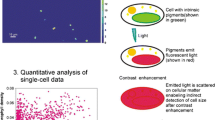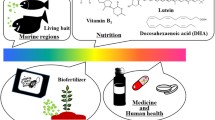Abstract
A largely unexplored area is the application of digital image processing to counting and sizing of microalgal cells from culture. Commercial systems are available, but have not been tested, nor necessarily optimized for high speed counting and sizing of phytoplankton. The present work describes the design, construction, specifications and comparative performance of an inexpensive system optimized for counting and sizing microalgal cells. This system has been tested with cells of the picoplankton to nanoplankton size ranges (1–20 μm). The hardware was a widely available standard microcomputer, an inexpensive video camera and monitor, and a video digitization board (frame grabber). A modifiable menu-driven program (PHYCOUNT) was written and provisions made to make this program available to other workers. The program is constructed such that it can be adapted to a variety of hardware setups Video digitization boards). Comparison of growth curves for microagae revealed there were no significant differences in division rate and cell yield as assessed by the image analysis method compared to manual counts with a hemacytometer. Several hundred cells were counted routinely within 10–15 s, far exceeding the counting rate achieved by hand tally. A variable transect feature allowed sampling every nth pixel and provided a substantial increase in execution speed. More than 1000 counts can be done per day. A protocol for the use of 96-well plates of polyvinyl chloride as counting chambers contributed to the processing of large numbers of samples rapidly. Other routines developed provided subtended area, defined the coordinates of cell perimeter, and derived cell length and width. The calculation of the latter two parameters was usually done off-line as data output is in standard numerical form accessible by other programs. Experience with daily use of the PHYCOUNT program and imaging hardware reveal that the system is reliable for cell counting and sizing. The presence of bacteria in the algal cultures does not affect cell counting or sizing.
Similar content being viewed by others
References
Allen RD, Allen NS (1983) Video-enhanced microscopy with a computer frame memory. J. Microsc. 129: 3–17.
Ballard DH, Brown CM (1982) Computer Vision. Prentice-Hall, Englewood Cliffs, 523 pp.
Boyd CM (1978) Perspectives for automated identification and counting. In Sournia A (ed.), Phytoplankton Manual. UNESCO, Paris, pp. 216–217.
Brown LM, Elfman B (1983) Is auto sporulation a feature ofNannochloris? Can. J. Bot. 61: 2647–2657.
Cunningham CR, Purewal, JS (1983) A microcomputer-based aid for counting plankton samples. J. Plank. Res. 5: 783–786.
Cynar FJ, Sieracki ME, Sieburth J McN (1985) Estimating plankton populations with the Apple II. Bioscience 35: 652–655.
Dietz TE, Diller KR, Aggarawal JK (1984) Automated computer evaluation of time-varying cryomicroscopical images. Cryobiology 21: 200–208.
Dytch HE, Bibbo M, Puls JH, Bartels PH, Wied GL (1986) Software design for an inexpensive, practical, microcomputer-based DNA cytometry system. Analyt. Quant. Cytol. Histol. 8: 8–18.
Ferson S, Rohlf FJ, Koehn RK (1985) Measuring shape variation of two-dimensional outlines. Syst. Zool. 34: 59–68.
Foley JD, van Dam A (1982) Fundamentals of Interactive Computer Graphics. Addison-Wesley, Reading, 644 pp.
Guillard RRL (1973) Division rates. In Stein JR (ed.), Phycological Methods. Culture Methods and Growth Measurements. Cambridge University Press, Cambridge, 289–311.
Hannsmann E (1973) Pigment analysis. In Stein JR (ed.) Phycological Methods. Culture Methods and Growth Measurements. Cambridge University Press, Cambridge 359–368.
Ingram M, Preston K Jr (1970) Automated image analysis of blood cells. Sci. Am. 223: 72–82.
Jackson GS, Hamilton P, Solomon K, Kaushik N (1984) A computerized plankton counter. Hydrobiologia 118: 225–228.
Jaffe MJ, Wakefield AH, Telewski F, Gulley E, Biro R. (1985) Computer-assisted image analysis of plant growth, thigmomorphogenesis, and gravitropism. Plant Physiol. 77: 722–730.
Parsons TR (1973) Coulter counter for phytoplankton. In Stein JR (ed.), Phycological Methods. Culture Methods and Growth Measurements. Cambridge University Press, Cambridge, 345–358.
Pettipher G, Rodriguez UM (1982) Semi-automated counting of bacteria and somatic cells in milk using epifluorescence microscopy and television image analysis. J. Appl. Bact. 53: 323–329.
Puls JH, Bibbo M, Dytch HE, Bartels PH, Wied GL (1986) Micro-TICAS: The design of an inexpensive video-based microphotometer-computer system for DNA ploidy studies. Analyt. Quant. Cytol. Histol. 8: 1–7.
Rosenfeld A, Kak AC (1982) Digital Image Processing, Vol. 2. Academic Press, New York, 349 pp.
Sandgren CD, Robinson JV (1984) A stratified sampling approach to compensating for non-random sedimentation of phytoplankton cells in inverted microscope settling chambers. Br. Phycol. J. 19: 67–72.
Sieracki ME, Johnson PW, Sieburth JMcN (1985) Detection, enumeration, and sizing of planktonic bacteria by image-analyzed epifluorescence microscopy. Appl. Environ. Microsc. 49: 799–810.
Smith RL, Wiedeman VE (1964) A new alkaline growth medium for algae. Can. J. Bot. 42: 1582–1586.
Sorokin C (1973) Dry weight, packed cell volume and optical density. In Stein JR (ed.), Phycological Methods. Culture Methods and Growth Measurements. Cambridge University Press, Cambridge, 321–343.
Spalding M, Dawson B (1986) Finding the Titanic. Byte 11(3): 96–110.
Steponkus PL, Dowgert MF, Ferguson JR (1984) Cryomicroscopy of isolated plant protoplasts. Cryobiology 21: 209–233.
Walton WH (1952) Automatic counting of microscopic particles. Nature (Lond.) 169: 518–520.
Wehr JD, Brown LM, O'Grady K (1985) Physiological ecology of the bloom-forming alga Chrysochromulina breviturrita Nich. (Prymnesiophyceae) from lakes influenced by acidic precipitation. Can. J. Bot. 63: 2231–2239.
Author information
Authors and Affiliations
Rights and permissions
About this article
Cite this article
Brown, L.M., Gargantini, I., Brown, D.J. et al. Computer-based image analysis for the automated counting and morphological description of microalgae in culture. J Appl Phycol 1, 211–225 (1989). https://doi.org/10.1007/BF00003647
Received:
Revised:
Accepted:
Issue Date:
DOI: https://doi.org/10.1007/BF00003647




